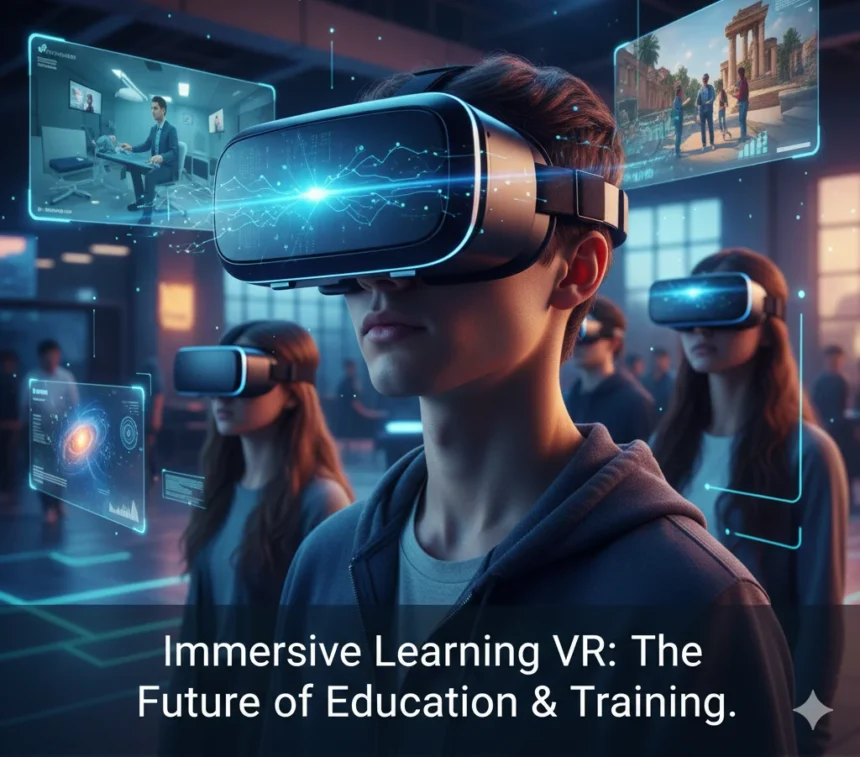Remember those vivid dreams where you could fly, explore fantastical worlds, or master complex skills with ease? What if we told you that a similar level of immersion, engagement, and hands-on experience is no longer confined to our subconscious but is rapidly becoming the cornerstone of modern education and training? Welcome to the exciting world of immersive learning VR.
For decades, learning has largely been a passive experience absorbing information from textbooks, lectures, and screens. While these methods have their place, they often struggle to capture our full attention or translate theoretical knowledge into practical understanding. Enter virtual reality (VR), a technology that has moved far beyond gaming and entertainment to fundamentally reshape how we learn, practice, and retain information.
This isn’t just about putting on an immersive learning VR headset; it’s about stepping into a simulated environment that mirrors reality so closely, or even surpasses it, that our brains respond as if we’re genuinely there. It’s about experiencing, doing, and interacting, rather than just observing.
What is Immersive Learning? Beyond the Textbook
Before diving deeper into the VR aspect, let’s clarify what is immersive learning at its core. Immersive learning is an educational approach that places learners within a simulated environment, allowing them to engage actively with the content, solve problems, and experience consequences in a safe, controlled setting. The goal is to create a deep, emotional, and sensory connection to the subject matter, leading to enhanced comprehension and retention.
Think of it as learning by doing, but without the real-world risks or logistical challenges. Whether it’s practicing delicate surgery, troubleshooting complex machinery, or navigating historical events, immersive learning removes the abstract barriers and makes the learning process profoundly personal and memorable.
The Power of Virtual Reality: Why Immersive Learning VR is a Game-Changer
Virtual reality amplifies the potential of immersive learning exponentially. By donning an immersive learning VR headset, learners are transported to a digitally constructed world, completely enveloped by the simulated environment. This level of presence is key to its effectiveness.
Enhanced Engagement and Motivation
Traditional learning often struggles with learner disinterest. VR, however, inherently captivates. The novelty and interactivity of a virtual environment naturally draw learners in, fostering a sense of curiosity and excitement. Instead of reading about the human heart, imagine shrinking down and flying through its chambers, observing blood flow and valve function firsthand. This level of engagement significantly boosts motivation and makes learning an enjoyable journey.
Superior Knowledge Retention
Our brains are wired to remember experiences. When we physically interact with information, our memory pathways are strengthened. Immersive learning VR capitalizes on this by transforming abstract concepts into tangible experiences. Studies have shown that learning through VR can lead to significantly higher retention rates compared to conventional methods. The emotional impact of an immersive experience, coupled with active participation, engraves the information more deeply into long-term memory.
Safe and Realistic Practice
One of the most compelling advantages of immersive learning VR is the ability to practice dangerous, expensive, or logistically challenging tasks in a safe, virtual space. Surgeons can hone their skills on virtual patients, pilots can practice emergency landings, and engineers can troubleshoot complex systems without risk of failure or damage. This not only reduces costs associated with physical training but also allows for repeated practice until mastery is achieved, without real-world consequences.
Bridging the Gap: Immersive Learning vs. Experiential Learning
It’s helpful to consider the relationship between immersive learning vs experiential learning. Experiential learning, in its purest form, involves learning through direct, real-world experiences. Think internships, field trips, or hands-on labs. Immersive learning, particularly with VR, aims to replicate or simulate these experiences.
While both are incredibly effective, VR offers unique advantages:
- Scalability: VR experiences can be replicated for thousands of learners simultaneously, anywhere in the world.
- Safety: Learners can make mistakes and learn from them without real-world repercussions.
- Accessibility: VR can transport learners to places, times, or situations that would otherwise be impossible or impractical to access (e.g., historical events, inside a nuclear reactor, deep space).
- Customization: VR environments can be tailored to individual learning needs and adapted on the fly.
Essentially, VR allows us to bring high-quality, impactful experiential learning to a broader audience, democratizing access to otherwise exclusive training scenarios.
Applications of Immersive Learning VR Across Sectors
The reach of immersive learning VR extends far beyond traditional classrooms, impacting a myriad of industries.
Education: Transforming Classrooms from K-12 to Higher Ed
What does immersive learning in education truly look like?
- K-12: Imagine history students walking through ancient Rome, science students dissecting virtual frogs, or geography students exploring distant continents. VR makes abstract subjects come alive, igniting curiosity and deeper understanding.
- Higher Education: Medical students can perform complex surgeries, architecture students can walk through their designs before they’re built, and engineering students can dismantle and reassemble virtual engines. This provides unparalleled practical experience that complements theoretical knowledge.
- Language Learning: Immersive learning language platforms place learners in realistic scenarios, like ordering food in a Parisian cafe or negotiating a business deal in Tokyo, allowing them to practice conversational skills in a low-stakes environment.
Corporate Training & Development
Businesses are rapidly adopting immersive learning VR to enhance employee training, leading to better-prepared and more productive workforces.
- Onboarding: New hires can explore their virtual office, meet colleagues, and understand company culture before their first day.
- Soft Skills Training: Practicing customer service scenarios, leadership challenges, or conflict resolution in VR allows employees to hone interpersonal skills in a realistic setting.
- Technical Skills: From operating heavy machinery to performing complex maintenance procedures, VR offers a safe and repeatable environment for mastering technical proficiencies.
- Safety Training: Training for hazardous environments, emergency protocols, or industrial safety can be conducted with zero risk, significantly reducing accidents and improving compliance.
Healthcare: Revolutionizing Medical Education and Patient Care
VR is making significant inroads in healthcare, from training future doctors to assisting current patients.
- Surgical Training: Surgeons can practice intricate procedures repeatedly, reducing error rates and improving patient outcomes.
- Anatomy and Physiology: Medical students can explore the human body in 3D, gaining a spatial understanding far superior to textbooks.
- Therapy: VR is used in pain management, phobia treatment (e.g., fear of heights), and rehabilitation, providing controlled exposure and therapeutic environments.
Military & Defense: Advanced Simulation for Critical Missions
The military has long utilized simulation, and VR takes this to the next level.
- Combat Training: Soldiers can train for complex missions in realistic, dynamic environments, honing tactical skills and decision-making under pressure.
- Vehicle Operation: Piloting aircraft, driving tanks, or operating submarines can be practiced extensively without the high costs or risks of real-world training.
- Situational Awareness: VR can simulate various scenarios to improve critical thinking and response times in high-stress situations.
The Components of an Immersive Learning Experience
A truly effective immersive learning experience relies on several key elements:
- High-Fidelity Visuals and Audio: Realistic graphics and spatial audio are crucial for creating a convincing sense of presence and allowing learners to suspend disbelief fully.
- Interactive Elements: Learners must be able to manipulate objects, interact with characters, and influence the virtual environment. This active engagement is fundamental to immersive learning.
- Haptic Feedback: Haptic gloves or vests can add a sense of touch, further enhancing realism and immersion. Feeling the vibration of a tool or the texture of an object can significantly deepen the experience.
- Learning Objectives & Feedback: Like any educational tool, the VR experience must be designed with clear learning objectives. Immediate feedback within the virtual environment, whether through visual cues, audio prompts, or scoring, helps learners understand their performance and adjust their approach.
- User-Friendly Interface: The technology should be intuitive and easy to navigate, allowing learners to focus on the content rather than struggling with controls.
The Road Ahead: Future Trends in Immersive Learning VR
The landscape of immersive learning VR is continually evolving, with several exciting trends on the horizon:
- Haptic Advancement: Expect more sophisticated haptic feedback systems that provide a wider range of sensations, making virtual interactions even more lifelike.
- AI Integration: Artificial intelligence will play an increasing role, creating more intelligent virtual characters, personalized learning paths, and adaptive difficulty levels. Imagine a virtual tutor that identifies your weaknesses and customizes the learning experience to address them.
- Augmented Reality (AR) & Mixed Reality (MR): While VR fully immerses you in a virtual world, AR overlays digital information onto the real world, and MR blends the two. These technologies will offer new avenues for “situated learning,” where digital learning content is integrated directly into the physical workspace or classroom.
- Cloud-Based VR: As VR experiences become more complex, cloud-based rendering will allow for high-fidelity graphics to be streamed to less powerful devices, making VR more accessible.
- Accessibility and Affordability: The cost of immersive learning VR headset and content creation is decreasing, making this technology more attainable for a broader range of institutions and individuals.
Conclusion: Embracing the Immersive Future
Immersive learning VR is more than just a technological fad; it’s a paradigm shift in how we approach education and training. By leveraging the power of virtual reality, we can move beyond passive consumption of information to active, experiential engagement that fosters deeper understanding, superior retention, and real-world competency.
From preparing the next generation of doctors and engineers to upskilling corporate workforces and enriching K-12 classrooms, the potential of immersive learning is boundless. As the technology continues to evolve and become more accessible, we stand on the cusp of a truly transformative era, where learning is not just effective but truly unforgettable. The future of education is here, and it’s brilliantly, breathtakingly immersive.
FAQs about Immersive Learning VR
1. What is the main difference between immersive learning and traditional learning methods?
The main difference lies in engagement and experience. Conventional methods (lectures, textbooks) are often passive and abstract. Immersive learning, especially with VR, places learners in a simulated, interactive environment where they actively participate, make decisions, and experience consequences, leading to deeper understanding and higher retention.
2. Is an expensive immersive learning VR headset required for immersive learning?
While high-end VR headsets offer the best fidelity, the cost of VR hardware is decreasing, and more affordable standalone headsets are becoming powerful enough for effective immersive learning. There are also mobile VR solutions using smartphones, though these offer a less immersive experience compared to dedicated VR headsets. The technology is becoming more accessible.
3. How does immersive learning VR benefit skill development for practical professions?
Immersive learning VR allows individuals to practice complex, dangerous, or high-stakes procedures in a safe, risk-free virtual environment. This means surgeons can hone their skills on virtual patients, mechanics can troubleshoot complex machinery, and first responders can train for emergency scenarios repeatedly until mastery is achieved, without real-world consequences or costs.
4. Can immersive learning VR be used for language acquisition?
Absolutely. Immersive learning language platforms are highly effective for language acquisition. They place learners in realistic virtual scenarios (e.g., ordering food in a restaurant, checking into a hotel, having a conversation with a native speaker) where they can practice speaking, listening, and cultural nuances in a low-pressure, interactive setting.
5. What are the main challenges in implementing immersive learning VR?
Key challenges include the initial investment in VR hardware and software development, the need for specialized content creation skills, ensuring accessibility for all learners (e.g., mitigating motion sickness for some individuals), and integrating VR solutions seamlessly into existing curricula or training programs. However, these challenges are being addressed as the technology matures and becomes more widespread.



